Rugby has long sold itself on the fact it’s a game of discipline. In terms of both the physical and also the laws. The game prides itself on both observing and pushing the boundaries. Get it just right and you’re team gets an advantage, get it wrong and well there are few other sports where the most minor lapse in judgement can change the direction of the game so drastically and completely.
Teams build their whole game plan around discipline. South Africa’s winning of the B&I Lions series was built on discipline both in defence and in making the most of their opponents lacking it.
A complex card system varies the punishment dished out on a sliding scale: In Round two it was Jordie Barret’s red card for striking the head with the foot, whilst this week (in round three) it’s the South African Captain’s Yellow card for a dangerous tackle.
Both incidents have brought words like reckless, intent and deliberate to the fore in understanding, criticising and defending the on-field sanction process.
What is very clear is that Barrets proved uneventful in terms of the game’s outcome whilst both Siya Kolisi and Willie le Roux’s yellow had a much larger impact on the final outcome of the game.
The card that I want to really focus on though is Kolis’s. Not in regards to is it or isn’t it a card but more the impact it had in terms of allowing Australia to build a lead that South Africa then had to chase with 14 men at a time where South Africa would normally be looking to tighten their discipline and suffocate their opponents in the 2nd quarter. (as we saw throughout the Lions series and vs Argentina).
The try, coming at a key moment in the game was a classic Brumbies play that we’ve seen countless times over the year at both Super Rugby and International level.
Instead, the game moves from 6-6 to allow Australia to score from one of their textbook plays stretching the lead out to 13-6 of the next play. South Africa are now 7 adrift, chasing the score with 14 men and that is draining
The Anatomy of a Try
Let’s break down that try in a bit more detail but I don’t think we can do that without acknowledging the impact of the card and the urgency that comes to Australia afterwards.
South Africa has been criticised heavily for their use of the kick chase but we get a good example of just why they do it in this clip.
Below we can see how the Australians have adopted a 13-2 defence (the 13th Australian is in the ruck, Cooper and Banks in the backfield) creating a solid defensive line from 15m to 15m. It’s good, speed is on the outside, heavy defence on the inside and the options for South Africa are limited.
Sure they can batter away at this line but everything is in the defensive team’s favour so ultimately what’s the point of expending energy in a confrontation you’re most likely to lose?
Rugby is also about intelligence and tactical advantage, so they’ve set themselves up for a kick chase.
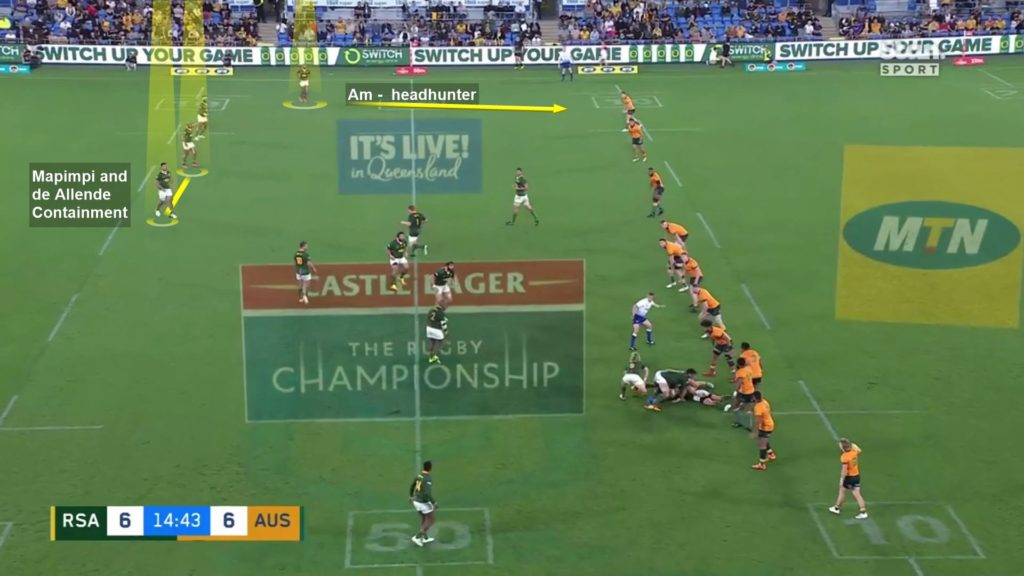
On the left, we can see the now-familiar principles of the South African kick-chase set-up. From out to in is:
- Am occupying the widest channel (1st Man/headhunter position on the far touchline).
- We then have Kolisi in the 2nd Man position (we’ll get to him in a second)
- and then the 3rd and 4th man positions are occupied by Mapimpi and de Allende
Am’s role is to chase and pressure the ball. Mapimpi’s role here is similar to Am’s but will pincer in from the 3rd man position to stop the catcher from cutting back inside.
De Allende from the 4th man position will drift in behind and defend the touchline or a break. He’ll be supported in this by the forward pod we see setting up in front of Pollard
In the next phase, we get a better view of Kolisi who fills an interesting role from the 2nd Man position.
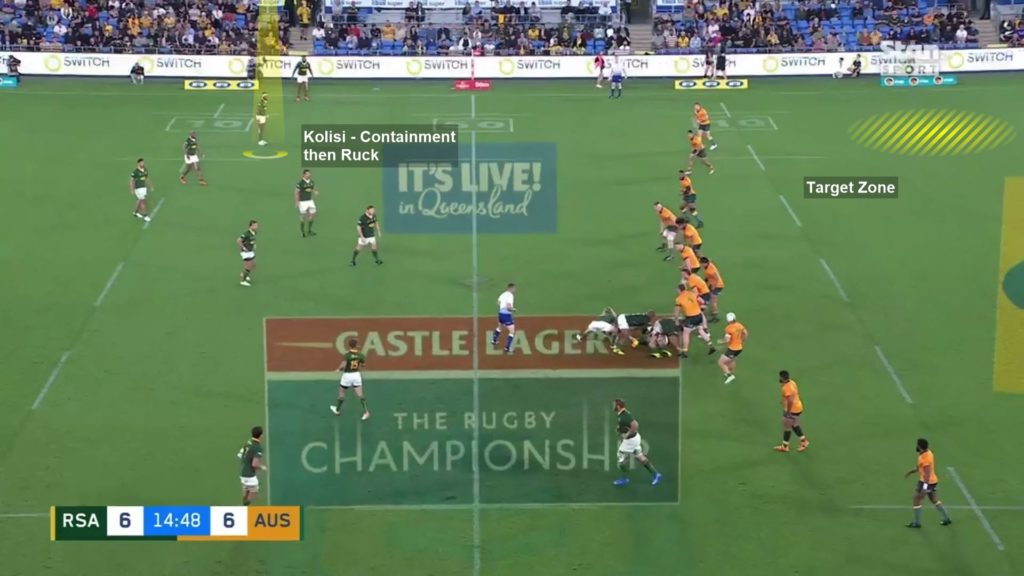
He has a few jobs here:
- slot in behind Am and clean up any issues should Am and Mapimpi be beaten (containement)
- If he’s not required to tackle then he will provide a counter drive at the tackle or ruck to win back the ball.
It’s a great strategy, if you look at the target zone we can see South Africa are not too worried about kicking to compete in the air this is all about isolating one of the two backfield players (on this occasion Banks) deep behind his defensive line.
This means Kolisi is coming forward followed by The 2 man pod we can see just in front of Pollard.
The Australians meanwhile would need to work back and around. Kicking like this puts almost everything in South Africa’s favour. Coaches, pundits and fans talk about attacking space and generating forward momentum. Well, this is a great example of a team trying to do exactly that.
The kick goes up and on fielding it Banks is driven away from his support towards Kolisi by both Am and Mapimpi.
Obviously, as we all know the yellow follows with Kolisi dumping Banks through the Horizontal but it’s a testament to Kolisi he doesn’t continue to drive him down and actually makes an attempt to bring him down safely.
It is unquestionably a yellow but in a game of small margins, it could have been so much worse.
Playing to your Advantage
This brings us neatly to the next stage, Australia’s pre-planned launch play from the following Lineout.
When a lineout is loaded like this Kolisi will quite often either slot into 10, or push out to the 12 positions with another back-row forward taking the inside channel, we saw him do it repeatedly against the B&I Lions and Argentina.
Australia knows with Kolisi gone and the Full lineout engaged Pollard will likely be left alone defending the 10 channel and seam.
We also know this is a pre-game call based on this rough scenario as everything is mapped out and executed at breakneck speed. From the instance:
Remember this isn’t a line outcall this is a strike move with forwards and back interlinking.
- Australia kick the ball to touch to it being back in play is 16 seconds: the Ball kicks at 15:34 – Lineout Throw caught at 15:48 – 14 seconds.
This means South Africa have almost no time to read the attack and adjust accordingly.
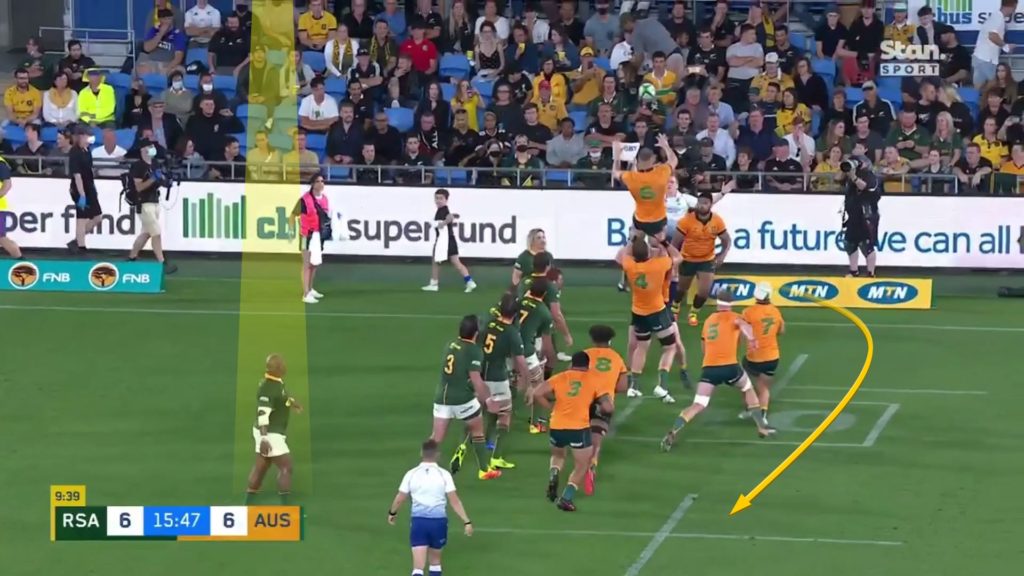
Australia throws and we can see the Idea here is for Fainga’a to come around and fix Mbonambi at the tail.
Hooper and Kellaway both track the ball and that occupies both Mbonambi and Malherbe leaving Kerevi completely unmarked and free to attack the seam with an aggressive “out to in” line.
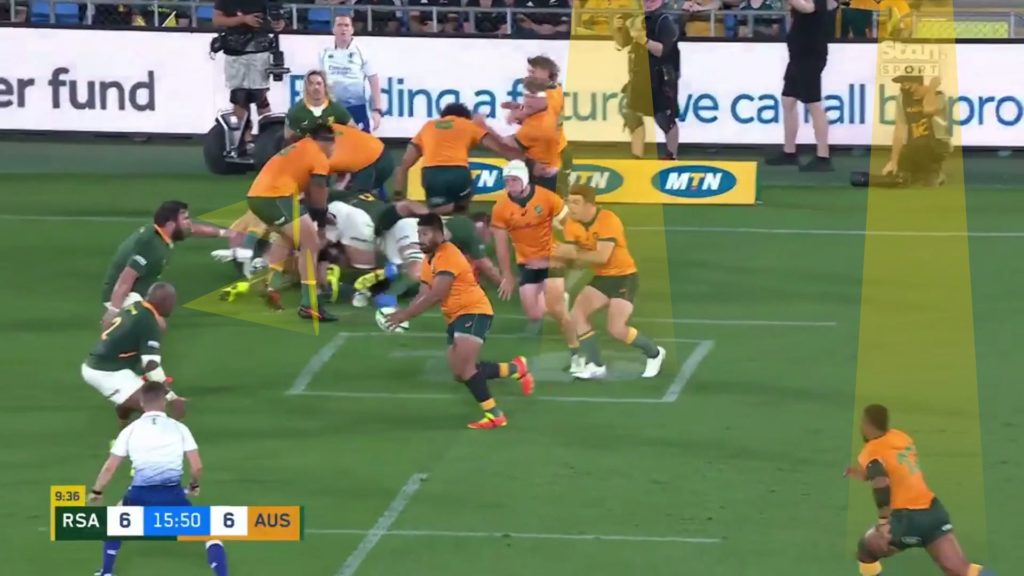
We can see exactly how effective this is as Kerevi is way over the gain line and free running.
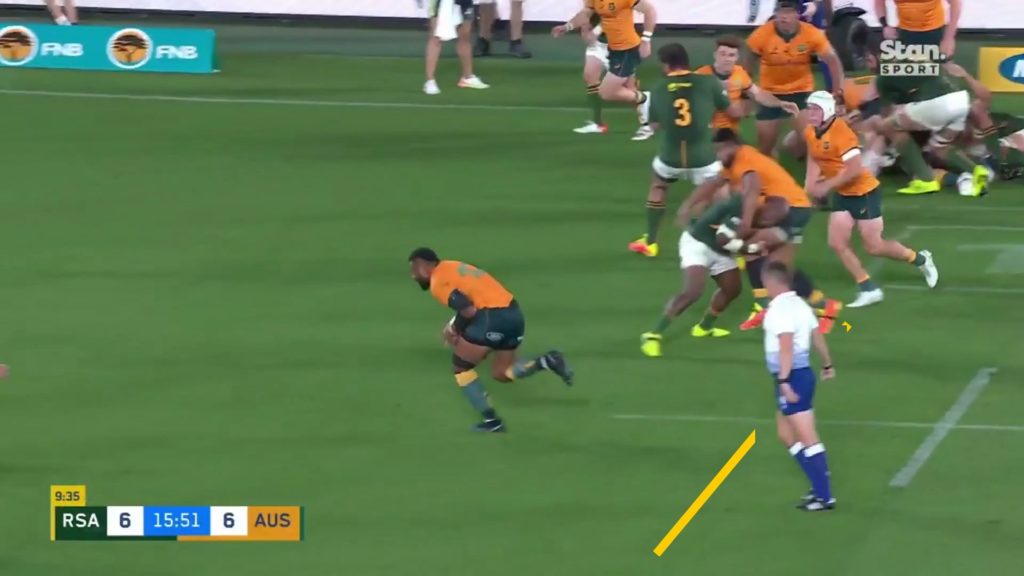
Now usually someone like Kolisi or Smith would step in to meet Kerevi it won’t stop him on the gain line but the knock-on effect means both Pollard and de Allende are dragged over to meet him.
In fact, when Pollard tackles Kerevi exactly 18 seconds have passed since the kick to touch. Australia is bringing a significant pace to the attack.
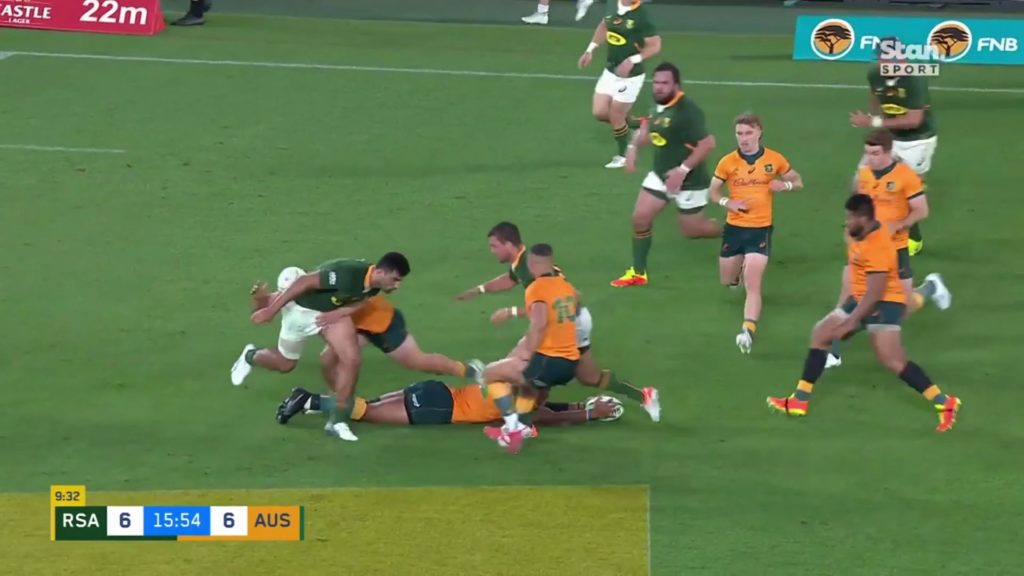
Notice how Hooper is able to clear de Allende and then restrains him after stopping the defensive reset.
Obviously what that does is keep the Springbok midfield narrow and as the ball is recycled we can see exactly how badly the bok’s line integrity has been compromised. Am is completely isolated here.
In fact, it’s perhaps a poor decision by Philip to take the ball into contact again.
With Nkosi stepping in the Wallabies could maybe have attacked the space between him and Am, fixed the outside defender and created a 2vs1 against le Roux with Banks and Korbiete (out of shot).
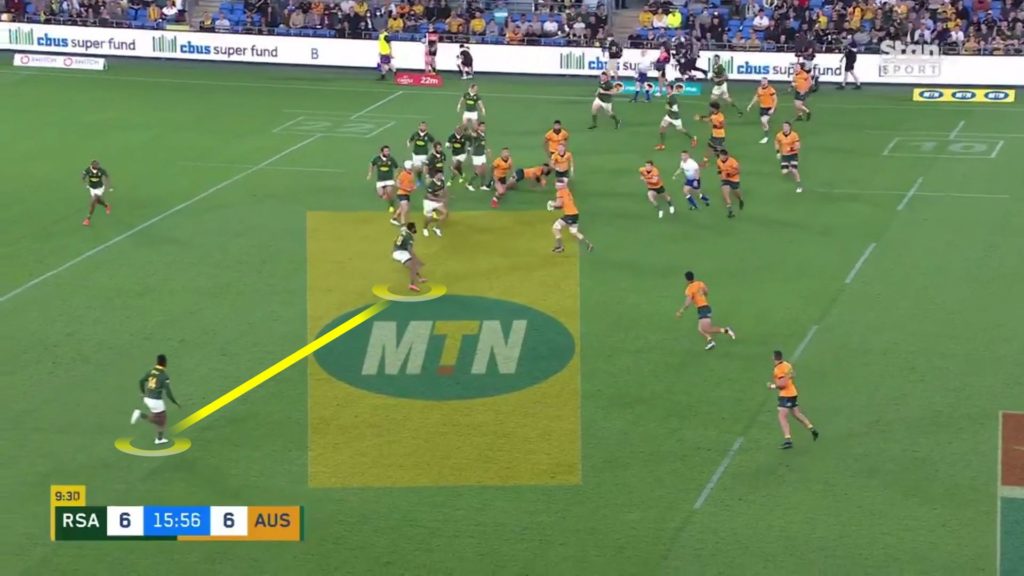
Small errors in decision making that on this occasion, thanks to the damage done by Kerevi’s carry and the speed they are playing allows Australia to move past.
Again as Australia playoff the next phase we can see the outside backs have slightly overshot Cooper and a 3 vs 2 is potentially wasted again as they’ve beaten the folding defence to the space.
It’s a great read by Nkosi to shut off the attack, but if Australia had held their depth just a fraction more I think they could have gotten outside that edge.
Australia recycles and South Africa has worked hard to regroup and create a defensive corner: Pollard, Mapimpi, Am and de Klerk are highlighted below.
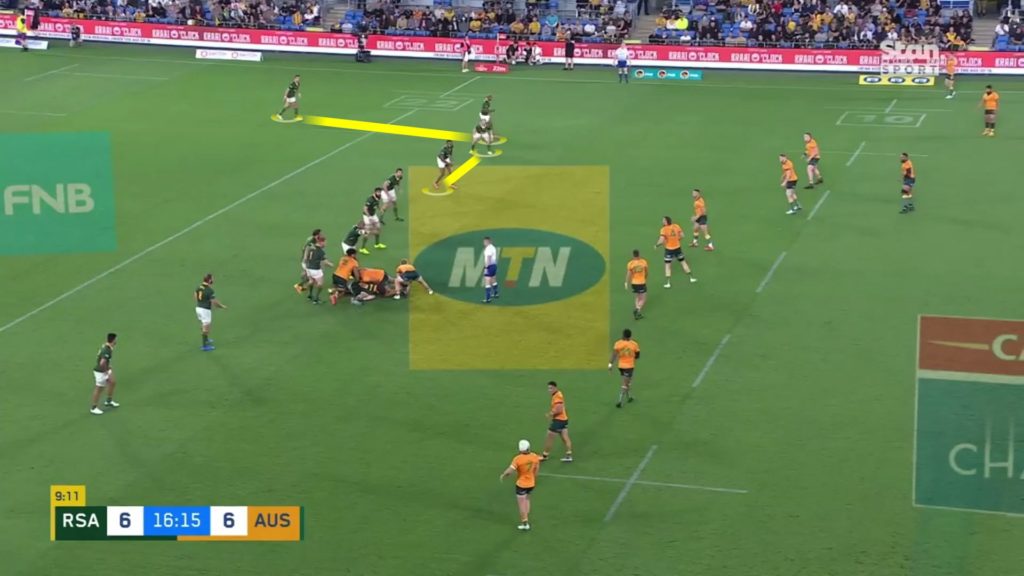
But we can also see that outside defence is outnumbered effectively a 6 vs 4 (if we count from Cooper on).
Cooper passes out the back and we can see both de Klerk and Mapimpi have gone for Kerevi.
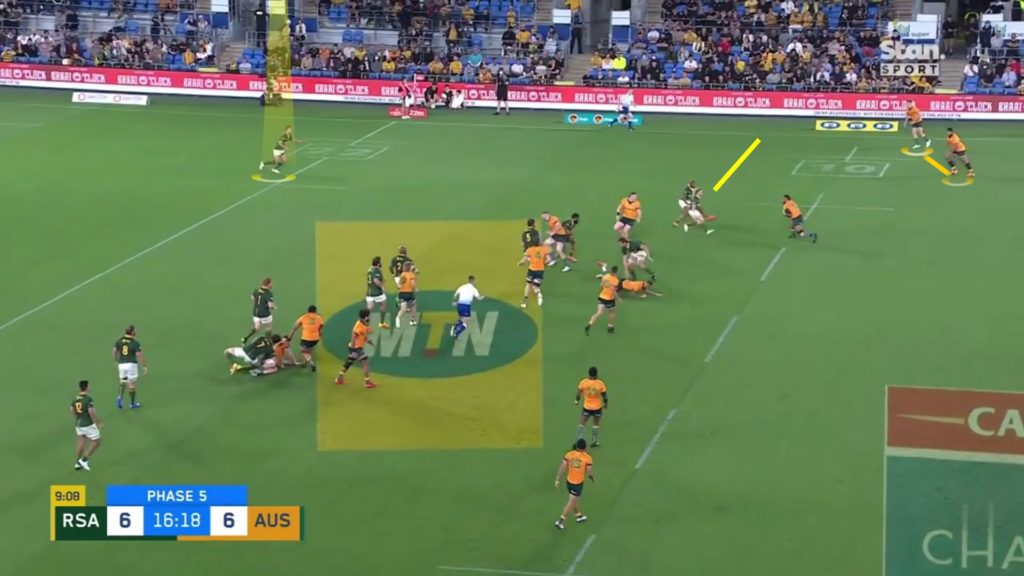
de Klerk coped a lot of criticism for this missed tackle but on numbers alone perhaps Mapimpi was in the best place, de Klek being held enough to make him drift late. Which ultimately opens the gate for Kerevi.
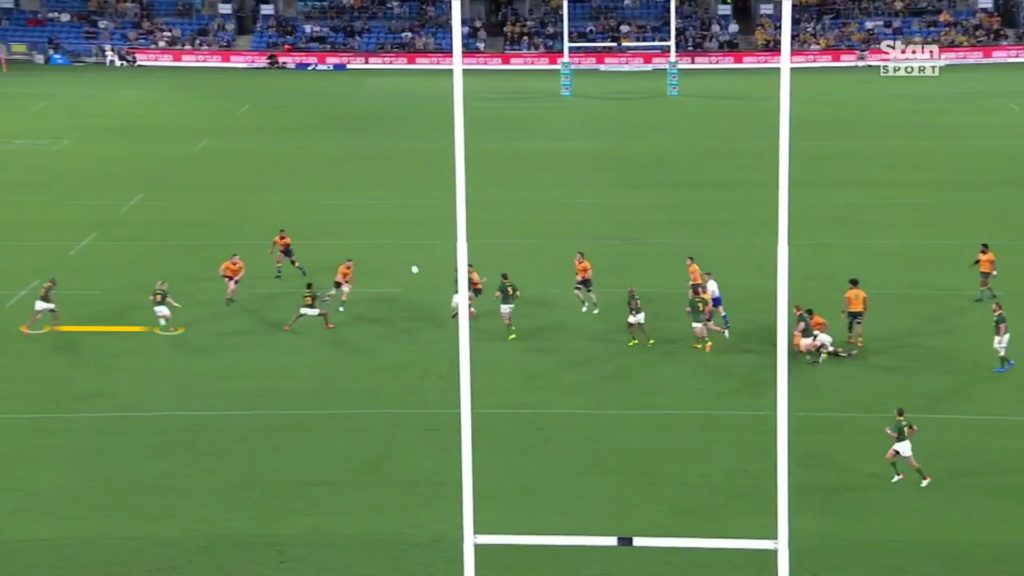
That’s not to say South Africa couldn’t have stopped this line break but the speed everything unfolds at is stressing the defence and communication issues happen.
For me, this is a great attack by Australia and a system failure for South Africa forcing players to work in isolation as they try to re-group.
It’s a great break by Kerevi who changes his line a fraction before he gets the ball. It’s worth noting that Cooper read the defence and his pass allows him to do this when he could easily have pushed Kerevi on to the outside with a less sympathetic pass.
It’s also worth noting how few South Africans are in a position to cover underneath the defensive line, only le Roux is in a position and he and Mapimpi (after a super turn and chase) are close to stopping this and with the momentum, Kellaway was always in a position to finish this.
South Africa are 7 points down in just under a minute of the actual ball in playtime following the yellow card.
One player down against a relatively still fresh, ball in hand attacking side like Australia is a dangerous place to be and while it’s easy to criticise South Africa for not adapting here the sheer speed of play and ferocity that Kerevi decimates their 1st phase defensive line with is very difficult to recover from.
The simple point of not having a defensive backrower in the 10/seam position has a profound impact on the subsequent phases as we see with Am being isolated. A player down means also means South Africa have to fold around the ruck constantly rather than just balance either side ready for the rewind from Australia. Kolisi is also key for their folding defence.
From the moment the line break comes South Africa are chasing everything that happens. Moving laterally in defence and fighting to mirror the attacking numbers.
A mistake leads to further mistakes and the impact of a misjudged tackle snowballs. Coaches talk about positive and negative momentum and how if you can create a series of positive interactions you can put yourself in a good position.
It will be interesting to see how South Africa bounce back from this, they are already 3 months into as arduous a campaign as you’re likely to see with the All Blacks looming on the Horizon this may be the loss they needed to bring focus to those details they perhaps got away with against the B&I Lions and Argentina.
For Australia it’s a good indication of where they stand, was the win unexpected? Not really, getting spanked by the All Blacks is not an uncomment event so the win will give them huge confidence that they are heading in the right direction but they’ll also know it wasn’t entirely an assured performance either coming down to a final kick.
Author: The Dead Ball Area




